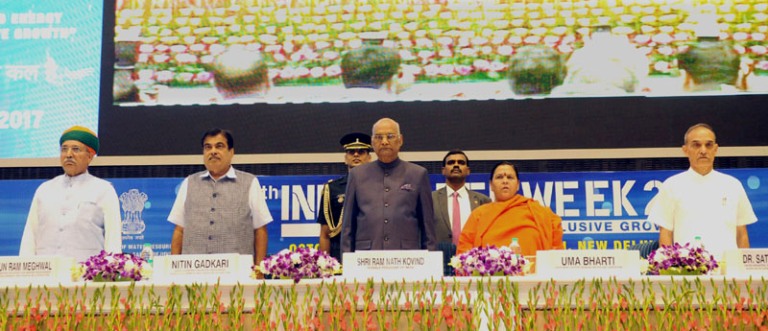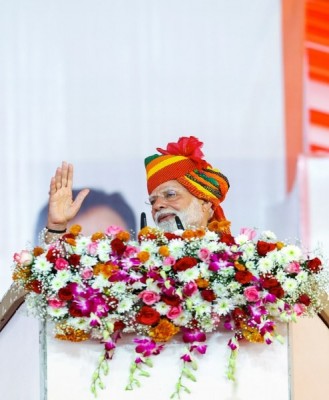
President Kovind says Central government aiming to provide drinking water supply in all rural areas by 2022
Speaking on the occasion, the President said that water is essential to life. It is fundamental to the economy and to ecology – and to human equity.
The President said that currently, 80 per cent of water in India is used by agriculture and only 15 per cent by industry. In the coming years, this ratio will change. The total demand for water will also rise. Efficiency of water use and reuse, therefore, has to be built into the blueprint of industrial projects. Business and industry need to be a part of the solution.
The President said that in urban India, 40 billion litres of waste water is produced every day. It is vital to adopt technology to reduce the toxic content of this water, and to deploy it for irrigation and other purposes. This has to be part of any urban planning programme.
The President urged a water management approach that is localised.

Among the dignitaries present on the occasion were Union Minister for Road Transport & Highways, Shipping, Water Resources, River Development and Ganga Rejuvenation, Nitin Gadkari; Union Minister for Drinking Water and Sanitation, Uma Bharti; Minister of State for Parliamentary Affairs and Water Resources, River Development and Ganga Rejuvenation, Arjun Ram Meghwal; and Minister of State for HRD and Water Resources, River Development & Ganga Rejuvenation, Dr Satya Pal Singh.
Excerpts from the President's speech:
"I am happy to be here to inaugurate the Fifth India Water Week 2017. I would particularly like to welcome the international delegates, from the European Union countries and elsewhere. They are joining their Indian counterparts in discussions related to this extremely important subject.
As we all know, water is essential to human life. In fact, since 60 per cent of the human body is water, it can be said that water is life itself. Without water, no field of human activity can be complete. Today, the world is debating if the flow of information is more important than the flow of energy. That is a good question. But the flow of water is still more important. It is fundamental to the economy and to ecology – and to human equity. The issue of water is becoming still more critical in view of climate change and related environmental concerns.
In India, water is central to some of our flagship programmes. I would go to the extent of saying that the modernisation of India is dependent on the modernisation of its water management. This is not surprising since our country supports 17 per cent of the global population – but has only four per cent of the world’s water resources.
Better and more efficient use of water is a challenge for Indian agriculture and industry alike. It requires us to set new benchmarks in both our villages and in the cities we build.
In India, 54 per cent of people are dependent on farming for their livelihood. Yet, their share of national income is only 14 per cent. To make agriculture more remunerative and to improve the prosperity of farming communities, the government has introduced many new projects. These include:
1. ‘Har Khet ko Paani’– Water for Every Farm: This requires enhancing the supply and availability of water
2. ‘Per Drop, More Crop’: This requires using drip irrigation and related methods to improve farm productivity, while using the same volume of water
3. ‘Doubling Farm Incomes by 2022’: To achieve this, the government is rapidly expanding the area under irrigation, and completing 99 long-pending irrigation projects. Sixty per cent of these projects are in drought-prone areas
I move now to India’s industrialisation and the role that water will play there. Under the Make in India mission, India is working to sharply increase the share of manufacturing in our GDP. From the current 17 per cent of GDP, we are determined to take it to 25 per cent by 2025.
Industry requires a large volume of water. This is particularly true for the manufacture of electronic hardware, computers and mobile phones. And these are all focus areas for Make in India.
Currently, 80 per cent of water in India is used by agriculture and only 15 per cent by industry. In the coming years, this ratio will change. The total demand for water will also rise. Efficiency of water use and reuse, therefore, has to be built into the blueprint of industrial projects. Business and industry need to be a part of the solution. That is why I am glad large manufacturing companies are present at this conference.
India is urbanising at a rate not seen in its history. An effort is being made to build or upgrade 100 modern cities as part of the Smart Cities initiative. As we know, reuse of water, solid waste management and better sanitation infrastructure and practices are benchmarks to assess Smart Cities.
In urban India, 40 billion litres of waste water is produced every day. It is vital to adopt technology to reduce the toxic content of this water, and to deploy it for irrigation and other purposes. This has to be part of any urban planning programme.
I must also point to the significant regional variations in India when it comes to the experience with water. On the one hand, groundwater sources are being savagely exploited and depleted in some of our northern and western states. On the other hand, in eastern and North-eastern states, there is the challenge of overflowing rivers and of regular flooding. Year after year, this damages human habitation and is leading to tragedies in countless families.
Only a multi-stakeholder and multi-pronged approach can address such calamities. This includes achieving an interlinking of rivers where feasible. It also necessitates a basin-wide management of river systems to both keep rivers clean as well as serve the purpose of different types of users. The Namami Gange project is a good start in this regard. We need to extend such thinking to other river systems in India and the Indian subcontinent, especially in the eastern part of our country.
In conclusion, I would urge a water management approach that is localised. It should empower village and neighbourhood communities and build their capacity to manage, allocate and value their water resources. Any 21st century water policy must factor in the concept of the value of water. It must encourage all stakeholders, including communities, to expand their minds – and to graduate from allocating a quantum of water to allocating a quantum of benefits.
Of course, this quantum of benefits will be dynamic. It will inevitably be linked to the mapping and forecast of livelihood patterns in human society. And these keep evolving.
Access to water is a byword for human dignity. For India, providing safe drinking water to a population spread across six hundred thousand villages and urban areas is not just a project proposal. It is a sacred commitment. The government has prepared a strategic plan for ensuring drinking water supply in all rural areas by 2022, when India complete 75 years of Independence. By that year, the goal is to cover 90 per cent of rural households with piped water supply.
We cannot fail. The deliberations of this conference have to ensure that we do not fail."
Image: PIB
Support Our Journalism
We cannot do without you.. your contribution supports unbiased journalism
IBNS is not driven by any ism- not wokeism, not racism, not skewed secularism, not hyper right-wing or left liberal ideals, nor by any hardline religious beliefs or hyper nationalism. We want to serve you good old objective news, as they are. We do not judge or preach. We let people decide for themselves. We only try to present factual and well-sourced news.







